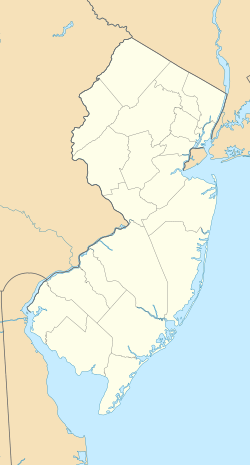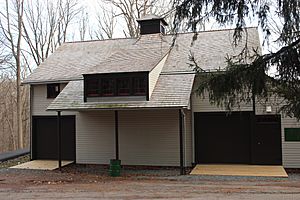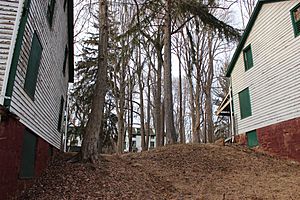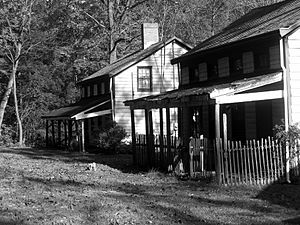Feltville Historic District facts for kids
|
Feltville Historic District
|
|
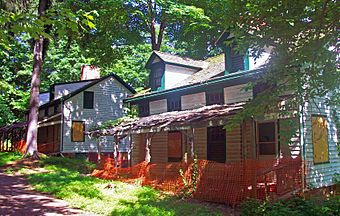
East elevations of two remaining vacant houses, 2009
|
|
| Location | Berkeley Heights, NJ |
|---|---|
| Area | 130 acres (53 ha) |
| Built | 1825–1882 |
| NRHP reference No. | 80002522 |
Quick facts for kids Significant dates |
|
| Added to NRHP | June 6, 1980 |
The Feltville Historic District is a special old area in Berkeley Heights, New Jersey. It's part of the Watchung Reservation in Union County. This district has many buildings from the 1700s. People often call it the "Deserted Village."
This historic area includes eight houses, a church, and other old buildings. Over time, Feltville was a busy mill town. It also became a farming community and a summer vacation spot. Today, only a few families live there permanently. The rest of the site is open for visitors. You can learn about its past or just enjoy the beautiful forest. Feltville was added to the National Register of Historic Places on June 6, 1980. It's important for its history in farming, business, and community planning.
Contents
History of Feltville: From Mill Town to Deserted Village
The first person to settle here was Peter Willcox. He came from Long Island around 1736. At that time, this area was a wild frontier. Peter Willcox built a sawmill. But as more people arrived, the sawmill was taken down.
David Felt was a businessman from Boston, Massachusetts. He moved to New York City in 1825. By 1844, his mill couldn't make enough paper to meet demand. So, Felt started looking for land in New Jersey. He wanted to build a second factory. He bought land from Peter Willcox's family. In just two years, he built a new mill on Blue Brook. He also built two dams and a town for his workers. He named this new town "Feltville."
In Feltville, David Felt was called "King David." He made sure everyone attended church services. He also required children to go to school. The school was in a single room. By 1850, about 175 people lived in Feltville. Often, four families shared a large house. Smaller houses were home to two families. A church called "Union Church" was also active. It had a pastor and welcomed all faiths.
After 15 years, "King David" Felt sold the property. Several businesses tried to take over, but they failed. The place then became known as "the deserted village." In 1882, Warren Ackerman bought Feltville. He turned it into a summer resort called Glenside Park. But soon, fewer people wanted to visit. They preferred to spend summers at the New Jersey shore.
After Glenside Park became deserted, the Union County Park Commission bought it. They made it part of the Watchung Reservation. The houses were rented to families. The buildings have been made stronger recently. In September 2011, Masker's Barn was restored. This building was a carriage house built by Warren Ackerman. From 1966 to 1984, it was used as a cafeteria and lecture hall.
Many of the original main buildings are no longer standing. Efforts are ongoing to preserve the site. This helps visitors imagine how people lived in Feltville-Glenside Park. The mill, Felt Mansion, dorms, and school are gone. But you can still see the mill's foundation. It's next to Blue Brook, downhill from the standing buildings.
Things to See and Do in Feltville
County staff often host fun activities on weekends. They have games for children. You can also see how apple cider is made. Sometimes, they display old items found from the past.
In October, two weeks before Halloween, there are haunted hayrides. Families can ride through the town. They learn about famous people from Feltville's history. Special effects are added to make it spooky!
The village is open to the public every day. There is a visitor center. You can pick up brochures there to learn more.
The Murals of Roberto de la Selva
In 1916, Glenside Park closed, and the Deserted Village became quiet. Edward J. Grassmann, a local engineer, bought some properties. He was a travel lover and wanted to create a club. Grassmann made his money from land surveying. He also processed a material called kaolin. His family's trust still exists today.
Grassmann decorated two buildings in the Deserted Village. He wanted to show his love for the Southwest and Latin America. He called one building the "Mexican Cottage." The other he named the "Indian Cottage."
It seems Grassmann convinced a famous artist to paint murals. This artist was Roberto de la Selva from Nicaragua and Mexico. In the late 1920s, de la Selva visited the United States. He spent months painting murals inside the Mexican Cottage. These murals show native Mexicans working, playing, and worshipping. They include statues of ancient gods and the Virgin Mary. Roberto de la Selva was mostly a sculptor. These murals are the only ones he is known to have painted. This makes them very important for Feltville's history and for art around the world.
In 2013, the site of these murals was recognized. Preservation New Jersey named it one of the 10 Most Endangered Historic Sites in New Jersey.
Ghost Stories of Feltville
There's a popular local story about ghosts in Feltville. People say three ghosts live in the house furthest down the path. The story began in 1912. Three young sisters went camping deep in the woods. But they never came back. Locals only found their bonnets. This scared the people living there. Almost half of the residents moved away. Those who stayed never let their children go deep into the woods alone again.



